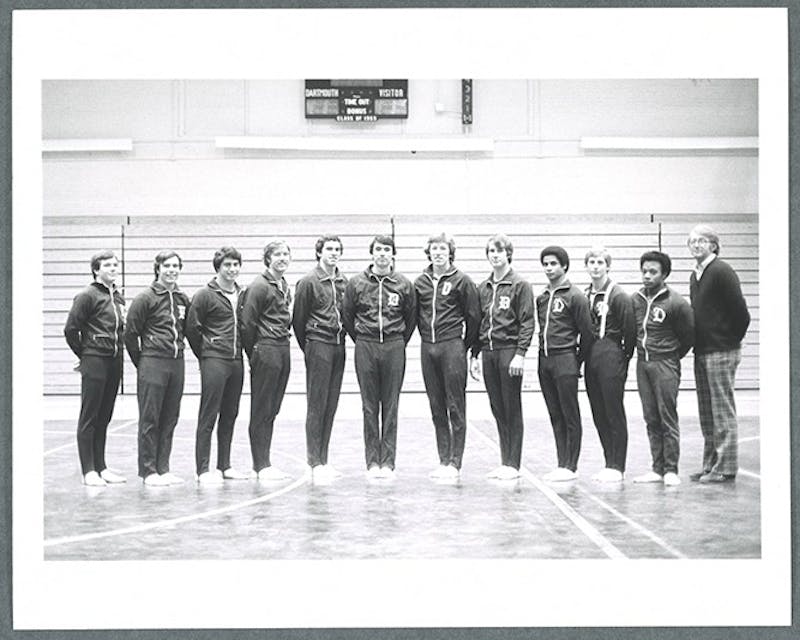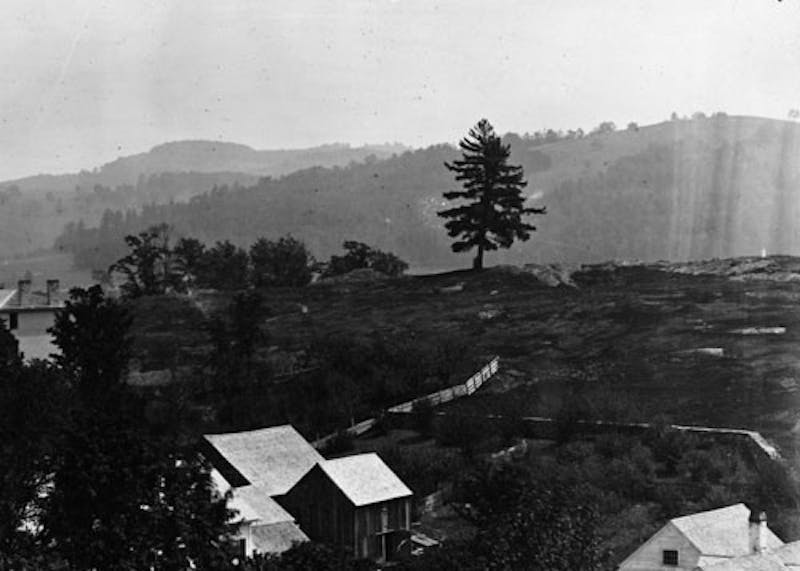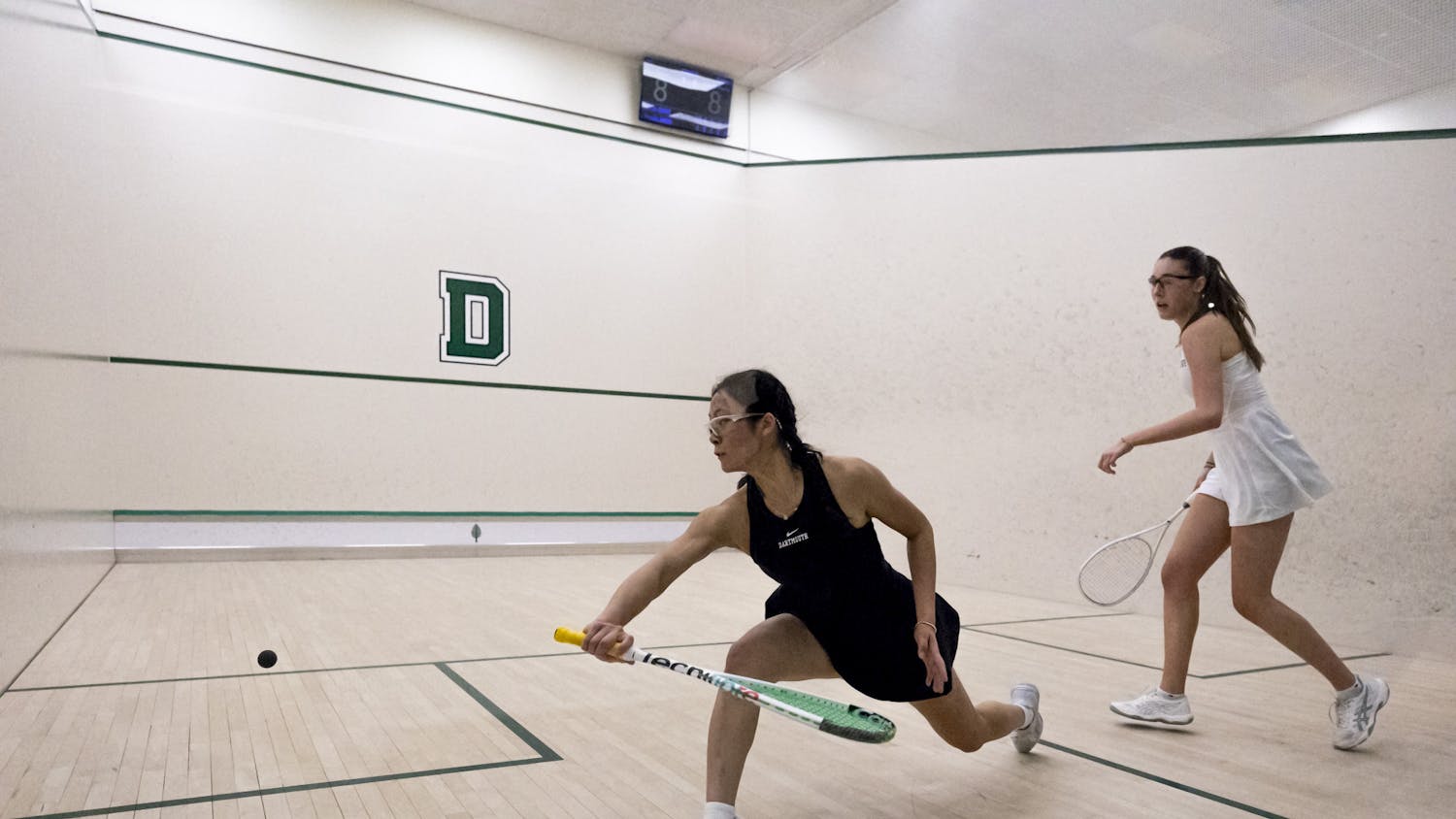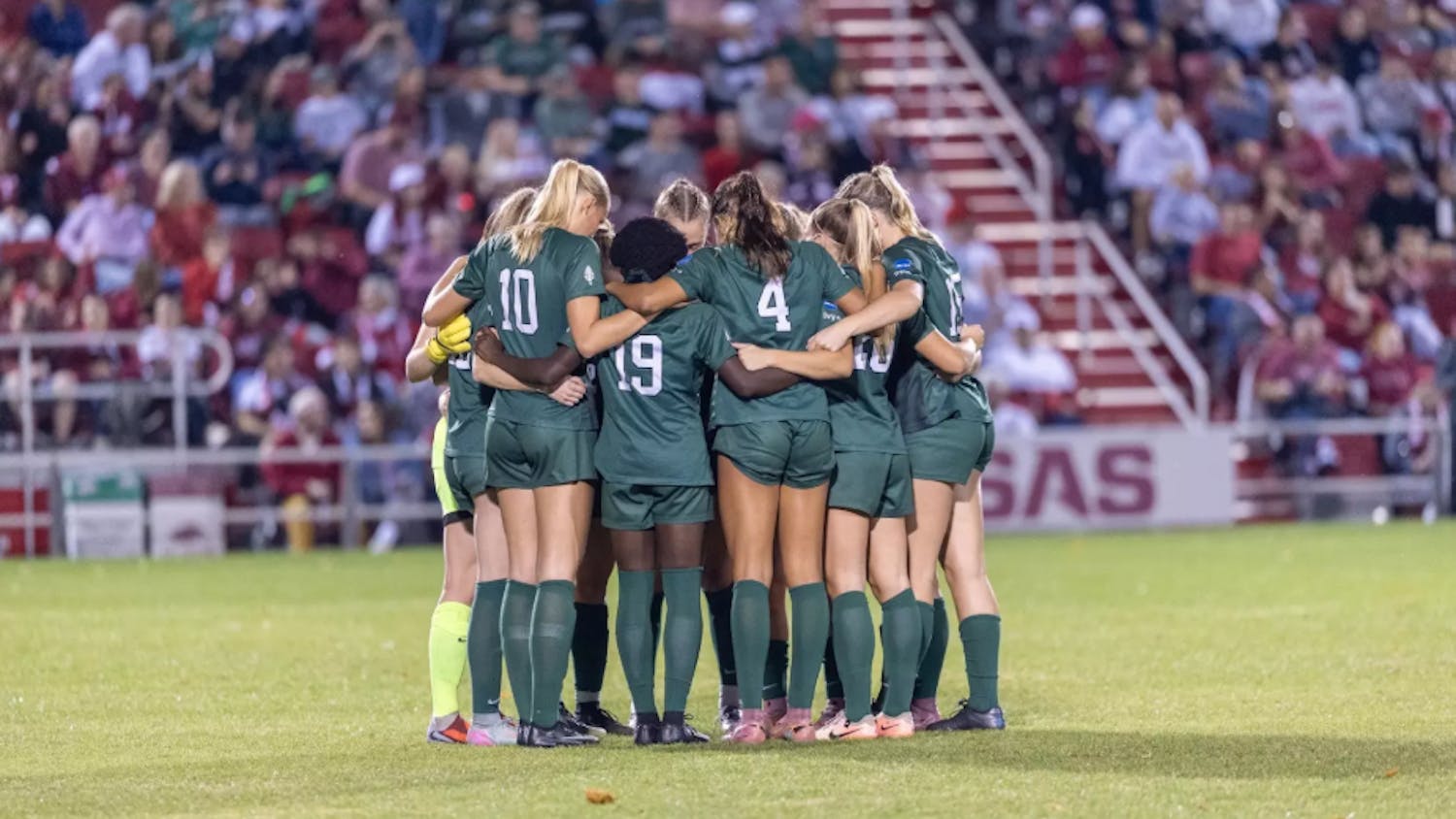With 35 varsity sports, 33 club sports and 24 intramural sports and more than 75 percent of undergraduates participating, it is safe to say that a love for athletics runs deep at the College. However, not many people know the evolution of Dartmouth’s varsity athletics program, beginning in 1769. This week, The Dartmouth explores the history of sports at the College through an overview of landmark events, traditions and obscure sports.
1769: Dartmouth’s Founding, Early Athletics
Originally founded as an institution to educate Native Americans, Dartmouth first officially recognized and recommended farming and similar manual labor to its students as a form of exercise. According to the 1893 book “Dartmouth Athletics: A Complete History of All Kinds of Sports at the College,” Dartmouth’s Original Code of College Laws recommended that students turn away from “puerile” activities such as playing with balls and bowls and instead focus on “exercises for their health,” including the “cultivation of gardens and other lands at the proper hours of leisure.” Of course, despite what the College hoped, “puerile” activities such as swimming and skating were still quite popular among early students.
1803: Beginning of Cricket
In a drawing by George Ticknor from 1803, a group of students are shown on the Green playing a game of wickets, more commonly known as cricket. While there is little evidence to confirm whether the game was ever extremely popular among the student body in the early 19th century, a group of students organized an unofficial cricket team with the help of faculty members. Currently, there is a Dartmouth Cricket Club that practices at Scully-Fahey Field.

1836: Cow Hunting
During the first half of the 19th century, disputes between students and townspeople over the use of campus and the Green for a pasture also became a form of athletics for both sides. It was not uncommon to have village cows casually roam on the Green, which prompted another popular game among students — cow hunting. In 1836, the “Senior Fence” was built to keep cattle off the College-owned Green. While free-range cattle was no longer a problem by 1893, students advocated for a portion of the fence to be left up. Fence sitting was considered a seniors-only perk where they could socialize; any underclassmen caught on the fence was dunked in a water trough. While this tradition is no longer in practice, the fence still stands on the southwest corner of the Green.
1866: Green Adopted as the Dartmouth Color
During a mass meeting spearheaded by A. A. Thomas, Class of 1867, students voted to make Dartmouth’s official color green. The students used a piece of ribbon to establish the shade of green, which can still be found in Rauner Library. In an article of The Christian Advocate published in 1908, the students described their selection as necessary “as one of the original colleges of the country to be represented by one of the primary colors.” While the inscription of the framed piece of ribbon suggests green was an “inspired choice,” according to some students it was a “fallback option” since it was the only decent color not taken. At the time of the article’s publication, Harvard University, Yale University and Brown University had adopted their respective colors. Many people describe the color as a forest green, but specifically on the Pantone Matching System, “Dartmouth Green” is PMS 349. A baseball game played in 1866 was also Dartmouth’s first intercollegiate game.
1867: Old Division Football
Unsurprisingly, football became the first game of all-college interest, but unlike the structured game we know today, the earliest games were “free pursuits of the ball by every student that was not physically incapacitated” according to a timeline on the Dartmouth football team’s website. Moreover, since the location of the College and lack of athletic structure made intercollegiate competition hard, the “Old Division” later known as “Whole Division” brought competition on campus between seniors and sophomores versus juniors and freshmen or two all-inclusive literary societies, Social Friends and United Fraters. Students played the game “mob football” style. Every year, the competition among the students culminated in a match called the Usual Football Rush or the Football Rush, which was played annually until 1948.
1880: Athletic Events
Three sports — football, baseball and track and field – dominated the athletic scene in the second half of the 19th century. While students played baseball in a similar fashion to how it is played today, track and field has changed quite a bit over the years. In addition to standard track and field activities such as the 100-meter dash, shot put and mile run, athletes also participated in potato races and tug of war. Branching off from track and field events, more obscure clubs such as the Dartmouth Bicycle Club and Dartmouth Lawn Tennis Club came onto the scene.
1885: Senior Canes
The tradition of customized senior canes began when A. Herbert Armes, Class of 1885, asked his friends to carve their initials in his walking stick before Commencement. The Class of 1886 and 1887 solidified the personalization of senior canes as a tradition. Overtime, this simple gesture evolved to include more elaborate carvings. In the late 1890s, Charles Dudley ’02 designed a popular Indian head cane, which after commercial production and a patent on the design, became the most common cane carried by seniors. Today, while it’s not a tradition for every senior to design their own walking sticks, some graduates, who are a part of a senior society, will carry canes carved with a griffin, sphinx, phoenix or other symbol during Commencement as the only public display of the student’s membership in his or her organization.
1892: Complete Athletics Overhaul
June of 1892 marked “the time...for the recognition of athletics in the general discipline and culture of the college,” according to one of the College’s trustees at the time. At this time, the College released a plan to change the future of its growing athletic program. After a thorough investigation of athletics at Dartmouth and other college, the Executive Committee of the Alumni and the Advisory Committee decided to implement a plan to correct “certain evils which had grown up with the loose and irresponsible management” of athletics. As a part of this plan, the College completely separated the management of its physical education and sports with faculty and trustees in charge of the former and alumni and undergraduates in control of the latter.
1893: Committee on Athletics Created
Building off of the plan from the prior year, the alumni elected a Committee on Athletics. This committee was made up of nine people: three alumni, three faculty members and three from the senior class, who were generally managers of the football, baseball and track teams and elected by their peers. The College left the entire management and control of various athletic sports to this Committee to formulate rules and regulations of the various sports teams, determine the eligibility of team members and how the program should raise and expend money. As a result, the alumni controlled the academic concerns of athletes.
1909: Freshmen Rule
Following other Northeast institutions such as Harvard, Dartmouth instituted the “Freshmen Rule,” which meant that only upperclassmen could play on varsity sports teams. Some college administrations justified the rule because they did not want freshmen to worry about competing when they should be focusing on making the academic transition from high school to college. On the other hand, other colleges implemented this rule in order to build their teams. An editorial published in 1909 from The Dartmouth argued the rule would “open the way for a larger number of participants and for wider competition” by offering “the opportunity for preparatory work.”
Dartmouth’s freshman teams were generally very competitive, most notably in basketball. However, due to the location of the College, there weren’t too many opponents for freshmen teams to compete against. Instead, for competition’s sake, early freshman teams participated in popular interclass competitions between all four classes.
1914: Gun and Rifle
Fred Harris, Class of 1911, founded Gun and Rifle as well as the Dartmouth Outing Club in 1909. With help from a small group of trap-shooting enthusiasts, the team constructed the first traps built in Hanover and the team held frequent contests with clubs from neighboring towns and competitions between other schools such as Harvard, Yale and Princeton University. Teams competed indoors, shot on their own range and exchanged scores via telegraph.
Most of Dartmouth’s rifle team’s members left college for war service during the 1917 season. In 1918, E.O. Briggs, Class of 1921, headed a small group of athletes who revived the team, which competed through two seasons but quickly disbanded in 1921 because of a lack of funds.
1914: Men’s Gymnastics
While informally introduced to the College in 1852, the men’s gymnastics team officially become a club sport in 1914, when they competed in a meet against Harvard, which resulted in a 27-27 tie. The team consistently ranked highly, earning varsity status in 1968. During its first year as a varsity sport, the men took second to the University of New Hampshire in the New England Gymnastics League and won its first Ivy League title in 1980 with an 8-2 record. In 1982, however, the College dropped its men’s and women’s gymnastics teams.

1918: Men’s Wrestling
W.W. Cummings Jr., Class of 1922, also known as the father of Dartmouth wrestling, started the movement that led to the sport achieving varsity status. During his time as a student, Cummings coached the first squad of wrestlers and captained the team during its second year. Despite his efforts, the earliest teams were not very good, with the earliest record on file a 0-4. After the 1923 season, there was an 18-year gap where the College did not have a wrestling program. The best record was from the 1972 and 1973 seasons, when the team went 10-3 and 10-7, respectively. Charles D. Estin ’74 helped lead that team in the heavyweight category from 1972 to 1974, scoring a total of 179 points as the lead scorer in the history of Dartmouth wrestling. In 1976, the College dropped wrestling from varsity sports.

1919: Fencing
A Dartmouth fencing team made its first unofficial appearance in an indoor athletic carnival held in Bissell Hall in 1891. However, fencing did not become officially recognized as a club sport until 1919. After Dartmouth went coed in 1972, the team achieved varsity status from 1975 to 1979 for men and 1976 to 1979 for women. In 1976, the men’s team performed inconsistently, moving from a top three spot in its conference to a spot in the bottom three in only a month. The women, however, managed to qualify for a few national intercollegiate women’s fencing tournaments.
Julie Sudikoff Weisman ’79 competed well in conference play and finished 24th at nationals in individual competition in 1979, the year that Dartmouth dropped fencing as a varsity sport.
At the time, fencing was not a popular sport, and women were just beginning to be respected as athletes, she noted.
“It was such a funny team and the circumstances were unusual. Even though we were a varsity team, we didn’t have money so we were sort of this rag tag travelling team,” Weisman said. “We somehow managed to qualify as a team. We had some moments of glory, but we never did very well at nationals.”
In 1992, the team reformed as a club and remains a part of Dartmouth today, even taking home a first place finish at the National Club Championships in 2014.

1945: Ivy Group Agreement Signed
Although limited to football, the first “Ivy Group Agreement,” signed in 1945, affirmed the “observance of common practices in academic standards and eligibility requirements and the administration of need-based financial aid, with no athletic scholarships.” As a result of this agreement, the Ivy League created multiple committees including the Presidents’ Policy Committee, consisting of the presidents from the Ancient Eight institutions, the Coordination and Eligibility Committee, “made up of one senior non-athletic administrator from each school” and the Committee on Administration, comprised of the eight athletic directors.
1954: Ivy League Formed
The Ivy League presidents extended the Ivy Group Agreement to all intercollegiate sports, forming the Ancient Eight conference, in which Dartmouth still competes to this day. Since the first year of competition in 1956, Dartmouth has won 138 Ivy League Championships as the sixth most in the conference. Princeton leads with 465 championships, while Harvard has 404. Since 1957, Dartmouth has won 38 individual NCAA championships, which is the most of any other Ivy League institution, and three team NCAA championships.
1967: End of Freshman Beanies
As part of a requirement, freshmen had to wear the iconic green baseball cap with their class year sewn on for part of the school year, unless first-year students won the annual tug-of-war against upperclassmen on Dartmouth Night, which is the Friday of Homecoming. The hat identified freshmen to upperclassmen, who often hazed them. In 1963, the freshman class burned their beanies on Dartmouth Night, foreshadowing the end of this tradition in 1967.
September, 1972: Dartmouth Becomes Coed
Despite poor student response to the College becoming coeducational, Dartmouth admits its first class of women to the College and its first class of female athletes.
1984: Wearers of Green Established
The Wearers of Green, Dartmouth’s Athletic Hall of Fame, honors students, alumni and coaches who have achieved specific criteria for athletic excellence in their respective sports. Current “wearers” include Olympians, All-Americans, National champions and major league professionals. Over the last three decades, more than 1,200 members have been inducted during a ceremony that occurs annually during Homecoming.
The Evolution of Dartmouth’s “Unofficial” Mascot
While we are now referred to as the Big Green much like Harvard and Cornell are known as the Crimson and the Big Red, respectively, we have had several unofficial mascots. During the past 25 years, various student initiatives have proposed numerous candidates for a tangible mascot, symbol or nickname that could be used in addition to or an alternative to the Big Green. To date, none of these recommendations has received sufficient broad-based support from students or alumni to merit adoption.
Lone Pine
Originally known as the Old Pine, the Lone Pine refers to the pine tree, which stood on the hill behind the observatory and served as a gathering place for graduating seniors in 1828. In 1854, the location of the tree also served as the location for Class Day. After suffering damage in an 1887 lightning strike and an 1892 windstorm, the tree was cut down in 1895. The Lone Pine was admitted into the American Forestry Association National Hall of Fame in 1922 and was cited by the U.S. Department of Agriculture as a “Famous Tree” in 1938. In 1967, the Class of 1927 planted a homage to the Lone Pine, which now grows at the entrance to the BEMA.

Indian Symbol
In the 1920s, sports writers nicknamed Dartmouth sports teams “the Indians,” referring to the College’s founding mission. For the next 50 years, the nickname, though never officially adopted by the College, was used actively and interchangeably with the Big Green by the media. Moreover, in 1932, Walter Beach Humphrey, Class of 1914, created the Indian head symbol, which became popular among students in addition to appearing on uniforms of athletic teams as well as random novelties such as neckties, shirts and keychains. In 1972, the trustees declared the use of the Indian symbol “in any form to be inconsistent with present institutional and academic objectives.” The banning of the symbol was met with outrage from many alumni who clung to the old symbol and approval from the Native communities who were deeply offended by the symbol.
Keggy the Keg
An unofficial mascot conceived by Nic Duquette ’04 and Chris Plehal ’04 during their senior year, the world’s most famous anthropomorphic beer keg has made a variety of campus appearances since then, from cheering at football games to mingling with voters during presidential debates. Keggy the Keg’s schedule is unpredictable: Just when you think he’s gone for good, he arrives on the scene to stir things up.



